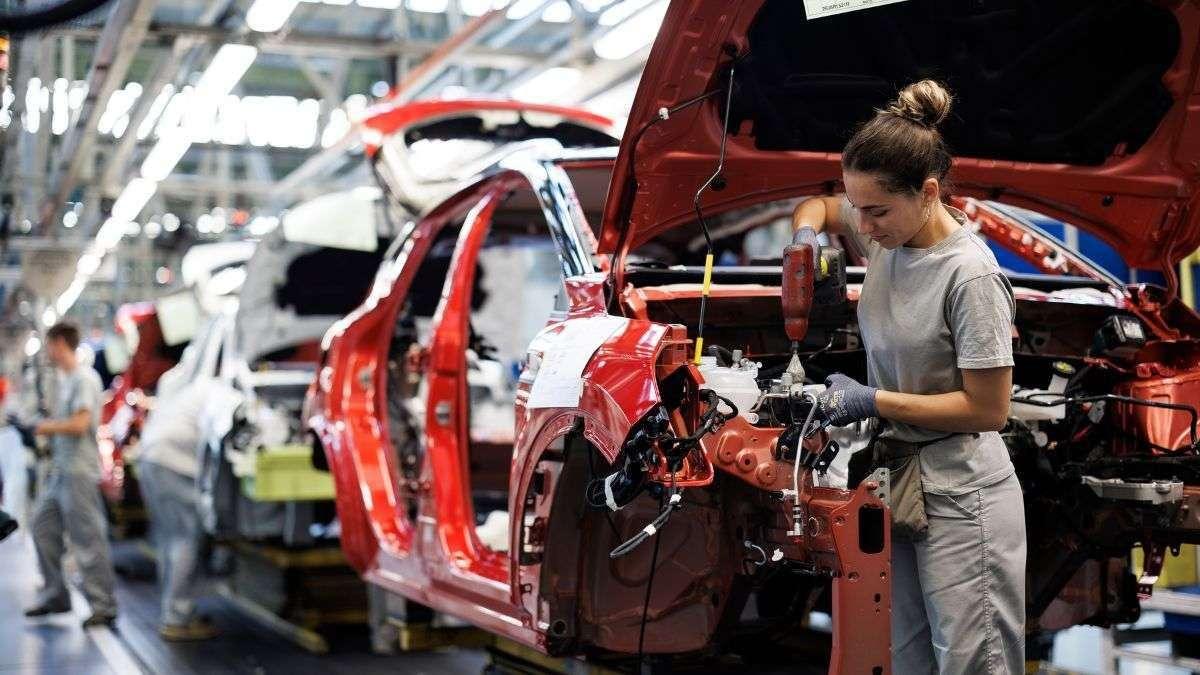- In many aspects, China is on par with and even surpasses the United States.Its economic, commercial and industrial capabilities are today similar, if not better, to those of the American giant.
This quantitative progress is accompanied by other progress in the field of research and innovation.China now dominates most fields of study in the study of important technologies, especially military applications;The most important articles on this topic are the works of Chinese researchers.
- This intersection of the two tracks comes in the context of the US's growing dependence on Chinese industry, while Beijing produces the world's rare earth arsenal.
- In terms of cutting-edge technology, many American companies have many things produced in China.
- The Chinese economic takeoff is not just a mass effect, linked, for example, to the size of the Chinese population: living standards are improving and life expectancy in China surpassed that of the United States in 2020. In a few years, the Chinese state developed an infrastructure network that took decades to implement in the United States.
1 - The United States lost its leading position in critical technological research
Over the past two decades, the United States and China have reversed their positions in scientific research in key technologies.
Washington, which dominated this academic field in 2000, has been placed in second place. Far behind Beijing, this is especially true in the field of military recruitment.
- According to a report by the Australian Strategic Policy Institute (ASPI), China dominates global scientific research in the period 2019-2023 in 57 of the 64 technologies (i.e. 89%) identified as "critical" by the institution.
- Twenty years ago, between 2003 and 2007, the US was dominated by Article 60 of these fields of study.1 Today, Beijing's dominance in technical research is mainly shaped in the area related to the Defense industry.
Bahd's The LaturehwherHotHo Ben Ras
China's institutional and research prominence in important technological areas is the result of increased investment in research and development, which accelerated especially in the 2010s.
- According to ASPI, China's dominance in these fields is not due to the decline in research activities of the "technological pioneers" (USA, UK, Germany, Japan), but due to Chinese development, which could not be matched later.
2 — In one year, China installed more solar panels than the entire existing fleet of the United States
In June 2025, Beijingle to put the same 100 new answers of the day.
Since the beginning of the year, 212 GW of new capacity has been connected to the grid, twice as much as in the second year of the United States (178 GW), the country second only to China in production.
- China's carbon dioxide emissions fell 1% in the first half due to unprecedented growth in new renewable energy capacity and a slowdown in construction.
The development of the installation of new renewable energy production capacity will be supported by the implementation of new measures to secure new contracts for producers.
- In July, the Chinese government announced new regulations on industrial pressure and cement, concrete, etc.
3 - While the Chinese Navy is falling, the Chinese Army is rising
The United States and its allies in Asia are also losing their position of military superiority, especially in conflicts such as the Taiwan Strait.
Today, China has the largest military fleet in the world with 370 warships and submarines.
Similarly, a large investment has been made in his army
- The People's Liberation Army has 550 intercontinental ballistic missiles (ICBMs), and its capabilities are far superior to those of its American counterparts.
- The progress curve for the number of nuclear weapons further suggests that the Chinese military could catch up with the US military in terms of deployed weapons by the 2030s.
4 - China has robotized its industry faster than any other country
Supported by the policy of large public investment, industrial robotization in China continues to grow and interest in robots on September 25, 2025. 2
- More than 29,5000 new robots were placed on the streets of China last year, an increase of 7% compared to the previous year.
– This is four times more than in the European Union (68,000 robots were installed last year), seven times more than in Japan (44.5 thousand) and almost nine times more than in the United States (34.2 thousand).
- Of the five countries (China, Japan, USA, South Korea and Germany) that installed more robots last year, only China maintained growth compared to 2023.
State-owned banks' offer of low-interest loans to industrialists, as well as assistance in purchasing foreign competitors, has also increased domestic production capacity.In 2024, and for the first time since 2014 when IFR began collecting annual data, the majority (58%) of industrial robots installed in Chinese factories were produced domestically.
5 - Business in China is much more dynamic than business in the United States
The strengthening of the positions of Chinese companies in global value chains is particularly noticeable in four major sectors of international trade: clothing, electronics, photovoltaics and automobiles.
- Globally, the impact of the round-19 dengue is seen in all regions, but the speed of recovery varies.China relaxes quickly and strengthens its presence in the international market, the US and Japan have met the same level and appear to achieve some stability, without significant gains or losses.
- As Dan Wang recalls in his analysis of the Chinese takeover, "Chinese goods exports to the United States will peak in 2022, similar to 2018, the year the Trump administration imposed tariffs on Chinese products."3
- For its part, the ability of the US auto industry to recover depends primarily on whether the various tax breaks and subsidies contained in the Anti-Inflation Act, many of which have already been frozen since returning to the White House, will be maintained.
6 — In industry, China controls the US value chain
Beijing also plays a key role in industrial value chains, to the point of being an essential link in the production of many cutting-edge technologies.
As Dan Wang pointed out, citing Apple's suppliers of 4,156 of the company's top 200 suppliers based in China, 72 of them are in Guangdong, which is the sum of those in the United States, Vietnam and India combined.
- In 2024, a report from the United Nations Industrial Development Organization (UNIDO) estimated that between now and 2030, China would concentrate 45% of the world's industrial capacity.5
- Today, the manufacturing industry represents 28% of Chinese GDP, compared to 10% in the United States, a difference explained by the American economy.6
7 - Beijing dominates rare earth corners Washington
On October 9, 2025, the Internationa Chistina of Trade published new export control measures that extended its regulatory framework to rare countries.
These rules severely penalize the United States, which accounts for more than 50% of imports of 51 industrially important minerals.
- China was the leading source for 17 of them and in the top three for another 24, according to the United States Geological Survey.
- China already controls exports of rare earth elements, with 7 of them completely dominating the value chain.However, 5 new items were added, bringing the total number of materials subject to restrictions to 12 items.
- Restricted the export of dozens of equipment and materials used in the extraction and refining of these minerals.
China's actions could have a direct impact on the global semiconductor supply chain, making it difficult to manufacture AI chips;American economic growth now depends on the development of artificial intelligence.
- According to Harvard economist Jason Furman, US GDP growth in the first half of this year would have been just 0.1% without most AI-related data centers.8
In response to these restrictions, in recent months Washington has accelerated the creation of a national capacity to develop rare earths.
- In the year of July, the Trump administration found a specialized program in two other mining companies, as well as the largest US government in congressional equipment.10
8 — Life expectancy in China has reached that of the United States
According to data released by China's National Health Commission and the US Centers for Disease Control and Prevention, the average life expectancy of a Chinese person in 2020 has surpassed that of an American.
- The Covid-19 pandemic has caused a significant decline in the average age of birth in most countries affected by the coronavirus.
- In the United States, it rose from 78.79 years in 2019 to 76.33 years two years later, putting it below the average life expectancy in Saudi Arabia or China that year, which were 76.94 and 78.21 years, respectively, according to World Bank data.
Asia, along with Africa, is the region of the world that has experienced the greatest growth in life expectancy over the past decades.
In 1950, the average age of Asians was 41 years compared to 73 years in 2019.
-Comparing the development in Asian countries, China experienced a remarkable growth from the 1980s to the 1980s, after which the same growth as the developed countries began.
9 - Urban development in China: - A few years in American urban development
Along with the Chinese growth large-scale Urbanization policy.
Because of its size, it is beyond the American phenomenon.
- Between 2018 and 2019, China produced 4.4 billion tons of cement, almost as much as the 4.5-billion tons of the United States produced in the 20th century.11
- For 35 years, the Chinese state has built a new city every year the size of New York and Boston combined.12 Thus, Shenzhen's population increased from 300,000 in 1980 to 700,000 in 2000.In 2020, it reached 18 million people.13
This urbanization occurs in parallel with the increase in average living standards in China
- Some indicators, such as the consumption of coffee or the ownership of animals, show the evolution in the standard of living that has given rise to domestic demand.
- As incomes rise, the Chinese are expected to shift from goods to services as the main driver of growth.Beijing is counting on this change to support its growth, while the Trump administration's tariff policy has hampered its export model.
The share of global GDP relative to the wealth of its own people is no different from that of Western countries.
- In 2023, GDP per Doita in the United States was $82,300, compared to $12,950 in China.
10 - China is ten times stronger in infrastructure than America
The collapse of the Francis Scott Bridge in Baltimore in March 202414 highlighted the gap between infrastructure development in the United States and the rest of the world.The situation in the United States cannot but be in sharp contrast with the large-scale construction policy pursued by China.
- Today, China has a longer high-speed rail network than all other countries in the world combined.15
- This network is developing very quickly: between 2003 and 2013, Shanghai expanded its network with several subway lines similar to those of New York's network.16
In general, American infrastructure has a significant investment deficit compared to those of Europe or China.
- In 2021, the OECD estimated that only 0.51% of the US GDP invested in building new infrastructure or improving existing ones;In the same year, 5% of Chinese GDP was devoted to infrastructure, ieten times more.
Footnotes
- Jennifer Wong Leung, Stephan Robin, and Danielle Cave, ASPI, tiarge Critical Technology Tracker: Rewarding Long-Term Investments in Research, 2024
- Robotics Māori 2025, International Federation of Robotics, 25 September 2025
- Eric Martin and Ana Monteiro, "US-China goods trade hits record even as political rifts widen," Bloomberg News, February 7, 2023.
-U "Apple 2023 Supplier List", Apple Inc., 2024.
- Industrial Development Report 2024, “Turning Challenges into Sustainable Solutions: A New Era of Industrial Policy,” United Nations Industrial Development Organization.
- Arendse Huld y Qian Zhou, China Manufacturing Tracker 2025, China Briefing.
- Gracelyn Baskeran, Meredith Schwartz, Consequences of China's New Export Restrictions, CSIS, April 14, 2025.
- Wedy Jason Furman at X.
- Tom Movernhout, MP Materials Deal Marks Significant Change in US Rare Earths Policy, Columbia Center on Global Energy Policy, 11 July 2025
- Jamie Samtle, Camilla Hodgson, Lauren Hodgson government, the US government will take $ 10% in trital setals, 17, 7 of ÓpisBe from 2025.
- Vice Guadav Smil, as the world really works, lordes, Penguin Books, 2022.
- Arthur Kroeber, The Chinese Economy: What Everyone Knows, Oxford University Press, 2016, p.67.
- « Shenzhen Assuline National National Date 2020 [1] (NR. 1) Posin Registration status, maybe 2021.
- Steve Thoncson, « long before the dam, Baltimore warns of 'warning boats, 23 de Mayo de 2024.
- luo Wang belongs to Lip EI election, "high-speed rail showcase again", China Daily, the sixteenth color of leather milk is not hot in 2024.
- "Shanghai Metro: Zero to Global Leader", The Shine, 8 September 2018.








